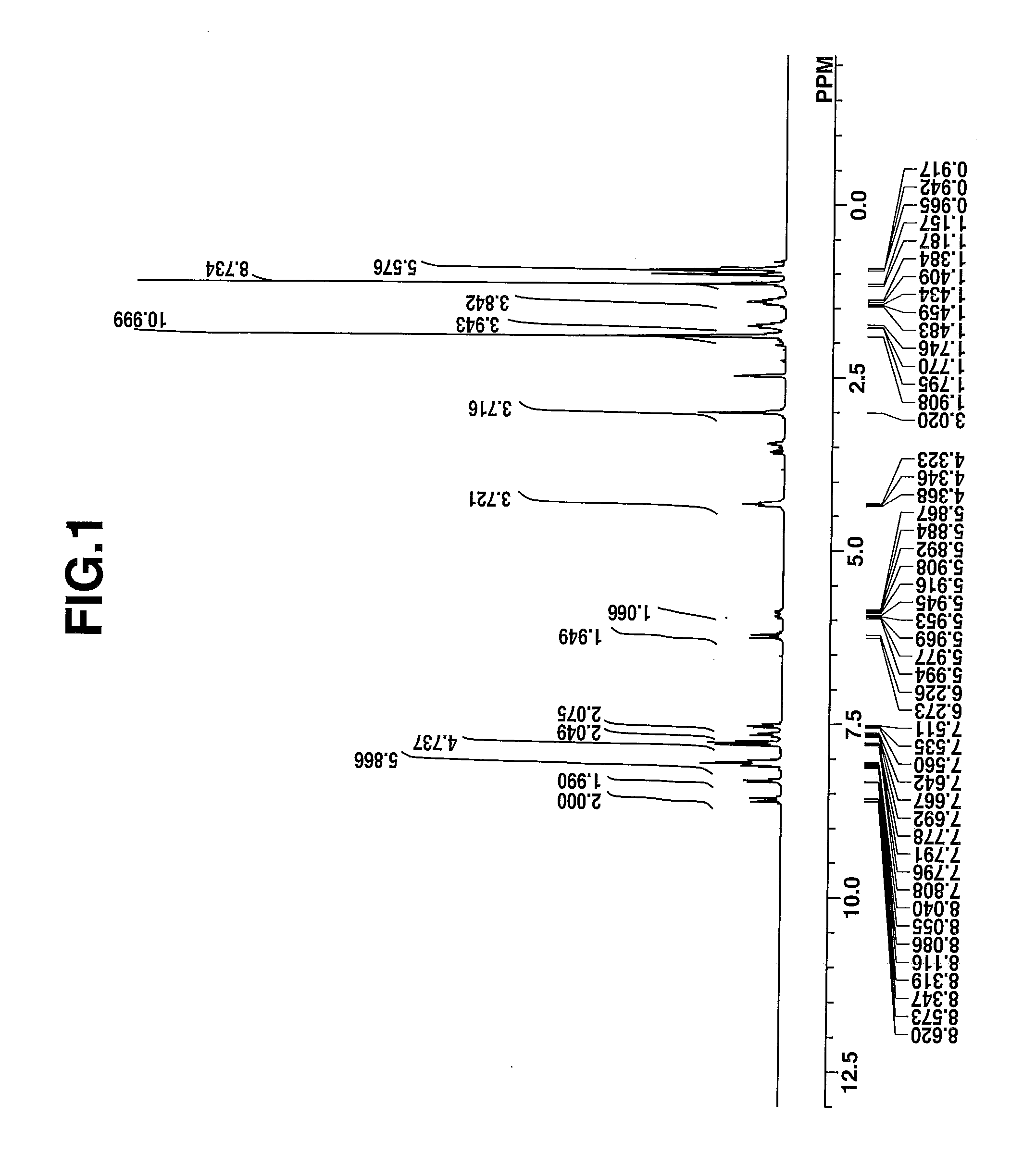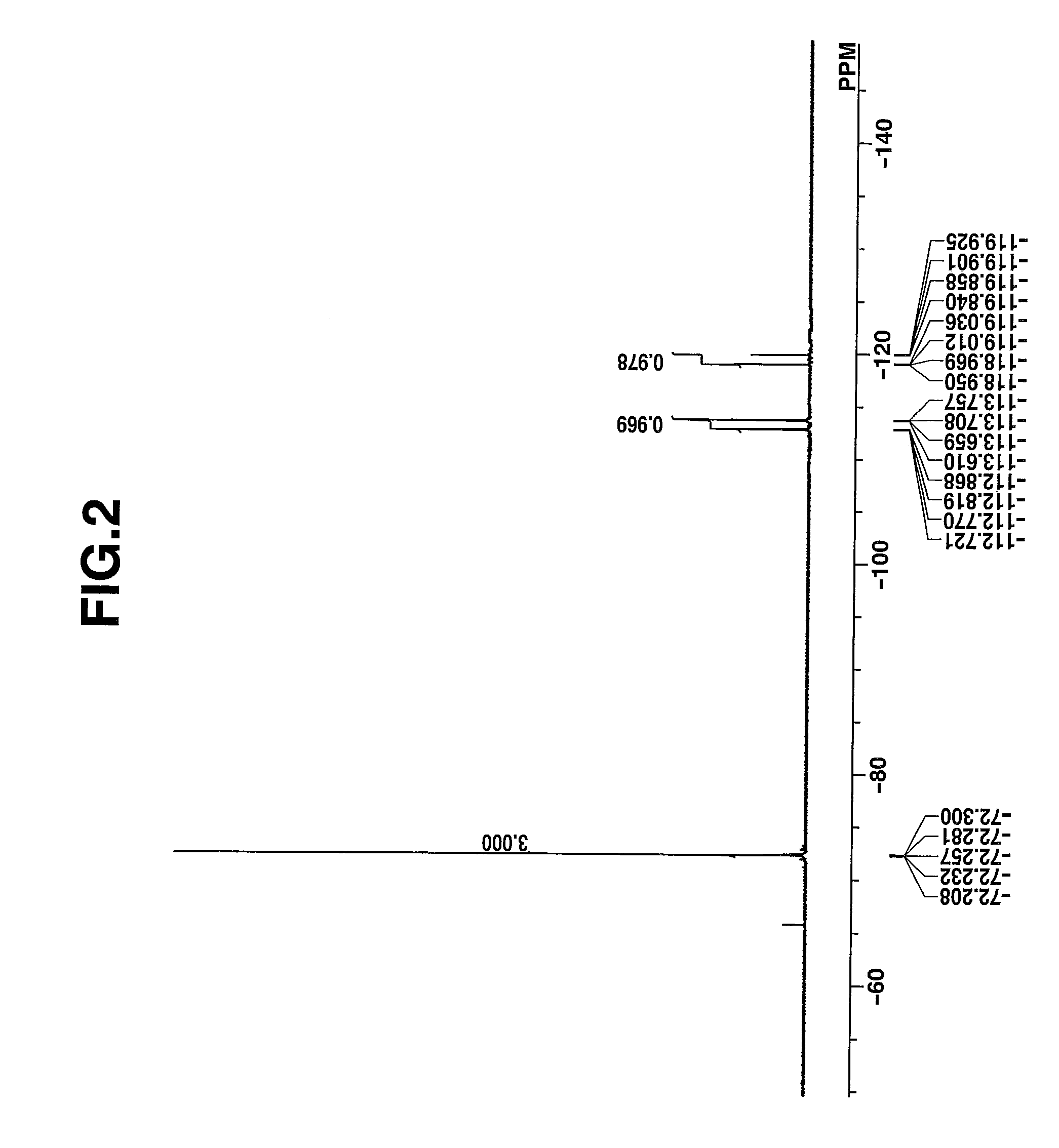Near-infrared absorbing dye, near-infrared absorptive film-forming composition, and near-infrared absorptive film
a technology of near-infrared absorption and dye, which is applied in the direction of photosensitive materials, lighting and heating apparatus, instruments, etc., can solve the problems of reduced solubility of nir absorption dye in organic solvents, poor and low solubility of organic solvents. , to achieve the effect of excellent solvent solubility, good optical properties and heat resistance, and easy coating
- Summary
- Abstract
- Description
- Claims
- Application Information
AI Technical Summary
Benefits of technology
Problems solved by technology
Method used
Image
Examples
synthesis example 1-1
Synthesis of 3-butyl-2-(2-{3-[2-(3-butyl-1,1-dimethyl-1,3-dihydrobenzo[e]indol-2-ylidene)ethylidene]-2-(phenylsulfonyl)cyclopent-1-en-1-yl}ethenyl)-1,1-dimethyl-1H-benzo[e]indol-1-ium 1,1,3,3,3-pentafluoro-2-(pivaloyloxy)-propanesulfonate, designated Dye-A.
[0114]
[0115]A mixture of 5.0 g (5 mmol) of 3-butyl-2-(2-{3-[2-(3-butyl-1,1-dimethyl-1,3-dihydrobenzo[e]indol-2-ylidene)-ethylidene]-2-(phenylsulfonyl)cyclopent-1-en-1-yl}ethenyl)-1,1-dimethyl-1H-benzo[e]indol-1-ium hexafluoroantimonate, 2.5 g (7.5 mmol) of sodium 1,1,3,3,3-pentafluoro-2-(pivaloyloxy)propanesulfonate, 40 g of water, and 40 g of methyl isobutyl ketone was stirred for 7 hours at room temperature, whereupon the organic layer was taken out. The organic layer was combined with 0.8 g (2.5 mmol) of sodium 1,1,3,3,3-pentafluoro-2-(pivaloyloxy)propanesulfonate and 40 g of water and stirred overnight, whereupon the organic layer was taken out. The organic layer was washed with water and concentrated in vacuum. Diisopropyl et...
synthesis example 1-2
Synthesis of 2-(2-[(3-{(2-(1,1-dimethyl-3-(2-hydroxyethyl)-1,3-dihydrobenzo[e]indol-2-ylidene)ethylidene]-2-(phenyl-sulfonyl)cyclopent-1-en-1-yl}ethenyl)-1,1-dimethyl-3-(2-hydroxyethyl)-1H-benzo[e]indol-1-ium 2-hydroxy-1,1,3,3,3-pentafluoropropanesulfonate, designated Dye-B.
[0120]
[0121]A mixture of 1.7 g (2 mmol) of 2-(2-{3-[2-(1,1-dimethyl-3-(2-hydroxyethyl)-1,3-dihydrobenzo[e]indol-2-ylidene)ethylidene]-2-(phenylsulfonyl)cyclopent-1-en-1-yl}ethenyl)-1,1-dimethyl-3-(2-hydroxyethyl)-1H-benzo[e]indol-1-ium bromide, 1.1 g (3.0 mmol) of benzyltrimethylammonium 2-hydroxy-1,1,3,3,3-pentafluoropropanesulfonate, 25 g of water, and 30 g of methyl isobutyl ketone was stirred for 6 hours at room temperature, whereupon the organic layer was taken out. The organic layer was combined with 0.8 g (2.0 mmol) of benzyltrimethylammonium 2-hydroxy-1,1,3,3,3-pentafluoropropanesulfonate and 30 g of water and stirred overnight, whereupon the organic layer was taken out. The organic layer was washed with ...
synthesis example 1-3
Synthesis of 2-(2-{3-[2-(1,1-dimethyl-3-(2-hydroxyethyl)-1,3-dihydrobenzo[e]indol-2-ylidene)ethylidene]-2-(phenyl-sulfonyl)cyclopent-1-en-1-yl}ethenyl)-1,1-dimethyl-3-(2-hydroxyethyl)-1H-benzo[e]indol-1-ium 2-(1-adamantane-carbonyloxy)-1,1,3,3,3-pentafluoropropanesulfonate, designated Dye-C.
[0126]
[0127]A mixture of 1.7 g (2 mmol) of 2-(2-{3-[2-(1,1-dimethyl-3-(2-hydroxyethyl)-1,3-dihydrobenzo[e]indol-2-ylidene)ethylidene]-2-(phenylsulfonyl)cyclopent-1-en-1-yl}ethenyl)-1,1-dimethyl-3-(2-hydroxyethyl)-1H-benzo[e]indol-1-ium bromide, 4.8 g (3 mmol) of 2-(1-adamantanecarbonyloxy)-1,1,3,3,3-pentafluoropropanesulfonic acid aqueous solution, 30 g of water, and 30 g of methyl isobutyl ketone was stirred for 8 hours at room temperature, whereupon the organic layer was taken out. The organic layer was combined with 1.6 g (1 mmol) of 2-(1-adamantanecarbonyloxy)-1,1,3,3,3-pentafluoro-propanesulfonic acid aqueous solution and 30 g of water and stirred overnight, whereupon the organic layer was t...
PUM
| Property | Measurement | Unit |
|---|---|---|
| wavelength range | aaaaa | aaaaa |
| mol % | aaaaa | aaaaa |
| mol % | aaaaa | aaaaa |
Abstract
Description
Claims
Application Information
 Login to View More
Login to View More - R&D
- Intellectual Property
- Life Sciences
- Materials
- Tech Scout
- Unparalleled Data Quality
- Higher Quality Content
- 60% Fewer Hallucinations
Browse by: Latest US Patents, China's latest patents, Technical Efficacy Thesaurus, Application Domain, Technology Topic, Popular Technical Reports.
© 2025 PatSnap. All rights reserved.Legal|Privacy policy|Modern Slavery Act Transparency Statement|Sitemap|About US| Contact US: help@patsnap.com



